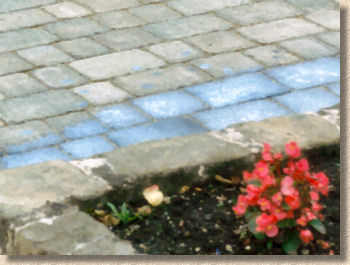Stabilising Compounds and Liquids
As more and more paving is jointed with dry sand and other loose materials , it has become apparent that heavy surface water flow (aka 'scour'), high-powered street sweepers and vacuums, weathering by wind and rain, and even occasional power washing can loosen and dislodge the jointing sand, leaving the joints empty and thereby compromising the integrity of the pavement. Several manufacturers have produced "Stabilising Compounds" that can be applied to dry sand joints on completion of the paving works, or later.
These compounds are typically a liquid that is applied over the surface of the paving from where it penetrates the jointing sand and begins to set or cure, binding together the individual grains of sand, and, in some cases, binding the sands to the edges of the paving. Any excess liquid left on the surface of the paving is rapidly worn off and the character of the work is unaffected.

Each stabilising compound has its own much-vaunted "unique formulation" - some are water based and set by evaporation while others feature a polymer resin and rely on curing by contact with air or residual moisture within the paving/bedding/jointing. While some are sold simply as joint stabilising liquids, others boast additional benefits, such as inhibiting weeds or waterproofing a surface.
Some of the most popular stabilising compounds in the UK/RoI are....
- Resiblock WJC - oxazolidine urethane prepolymer - specifically developed for joints in excess of 10mm
- Romex Joint Strengthener - ideal for all sorts of paving materials
- PavSeel - Jointing stabiliser and sealant often used with clay paviors
- Instarmac JointFix - Resin-based jointing stabiliser that also provides some anti-stain benefits
Other pointing and jointing pages...
- Introduction
- Terms & definitions
- Pointing Styles
- Spacers for Paving
- Cement Mortars
- - Hand Pointing
- - Pointing Riven Flagstones Using Coloured Mortar: A Case Study
- - Wet Grouting
- - Dry Grouting
- - Slurry Grouting
- - Gun Grouting
- - Poured Grouting
- Resin Mortars
- - Polymerics
- - GftK Polymerics: A Product Study - VDW 840+
- - Romex Polymeric Mortars: A Product Study
- - Jointex Polymeric Mortar: A Product Study
- - Slurries
- - GftK Slurry Mortars: A Product Study - VDW 800 Permeable
- - GftK Slurry Mortars: A Product Study - VDW 850
- Re-jointing paving
- Pitch Jointing
- Loose Fill Jointing
- - Stabilisation
- Alternative Jointing Materials
